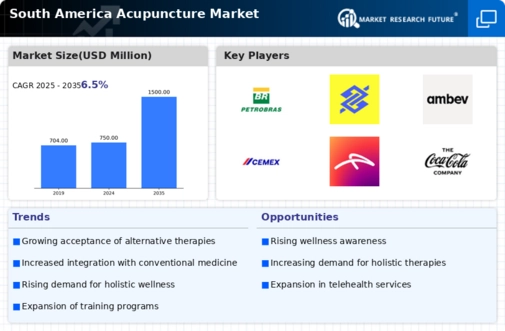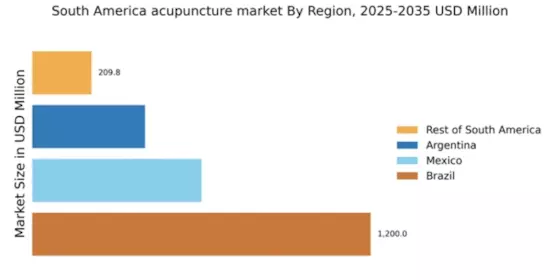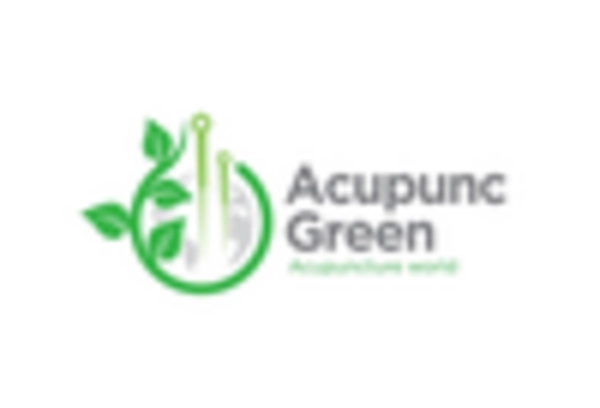Growing Interest in Preventive Healthcare
The acupuncture market in South America is significantly influenced by the growing interest in preventive healthcare. As individuals become more proactive about their health, they are increasingly turning to acupuncture as a means of maintaining wellness and preventing illness. This shift towards preventive measures is reflected in the rising number of wellness centers and acupuncture clinics across the region. Data suggests that approximately 40% of South Americans are now prioritizing preventive healthcare strategies, which may include acupuncture as a key component. This trend not only enhances the visibility of acupuncture but also positions it as a viable option for individuals seeking to enhance their overall health and well-being.
Increasing Demand for Alternative Therapies
The acupuncture market in South America experiences a notable surge in demand for alternative therapies. This trend is driven by a growing awareness of holistic health benefits among consumers. Many individuals are seeking non-invasive treatments for chronic pain, stress relief, and overall wellness. According to recent surveys, approximately 30% of South Americans express interest in alternative therapies, including acupuncture. This increasing demand is likely to propel the acupuncture market forward, as practitioners expand their services to meet the needs of a more health-conscious population. Furthermore, the rise of social media and online platforms facilitates the dissemination of information about acupuncture, enhancing its visibility and acceptance within the broader healthcare landscape.
Cultural Acceptance and Traditional Practices
Cultural acceptance plays a pivotal role in shaping the acupuncture market in South America. Many countries in the region have rich traditions of alternative medicine, which fosters a favorable environment for acupuncture practices. For instance, countries like Brazil and Argentina have seen a resurgence in interest in traditional healing methods, including acupuncture. This cultural inclination towards holistic approaches may lead to an increase in acupuncture practitioners and clinics. As more individuals embrace these traditional practices, the acupuncture market is likely to expand, with an estimated growth rate of 15% projected over the next five years. This cultural synergy between traditional practices and modern healthcare could enhance the legitimacy and appeal of acupuncture.
Technological Advancements in Treatment Methods
Technological advancements are reshaping the acupuncture market in South America, introducing innovative treatment methods that enhance patient experiences. The integration of technology, such as electronic health records and telemedicine, allows practitioners to offer more personalized and efficient care. Additionally, the development of acupuncture devices, such as laser acupuncture and electro-acupuncture, is gaining traction among practitioners and patients alike. These advancements may improve treatment outcomes and attract a broader audience to acupuncture services. As technology continues to evolve, the acupuncture market is likely to benefit from increased patient engagement and satisfaction, potentially leading to a growth rate of 12% over the next few years.
Rising Healthcare Costs and Accessibility Issues
The rising costs of conventional healthcare in South America contribute to the growth of the acupuncture market. As healthcare expenses continue to escalate, many individuals are seeking cost-effective alternatives for managing health conditions. Acupuncture, often perceived as a more affordable option, presents an attractive solution for those facing financial constraints. Reports indicate that acupuncture treatments can be up to 50% less expensive than traditional medical interventions for certain conditions. This economic factor, combined with increasing accessibility to acupuncture clinics, is likely to drive more patients towards seeking acupuncture services. Consequently, the acupuncture market may witness a significant uptick in clientele as individuals prioritize affordability in their healthcare choices.


















Leave a Comment